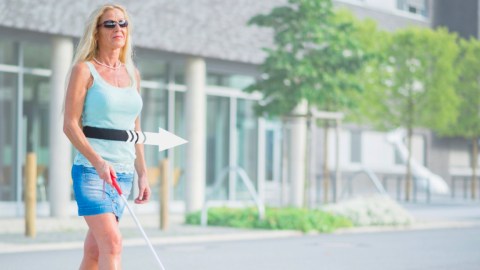How a Directional Belt for the Blind Could Create a Sixth Sense

If you’re the kind of person who likes to trust your gut when it comes to directional navigation, here’s a product that might be perfect for you. There’s an added bonus if you’re blind, or if you’ve always wanted a sixth sense that didn’t involve seeing dead people.
It’s a vibrating navigational belt (der Navigationsgürtel in German) designed by Osnabrück-based startup feelSpace (site is in German), and programmed to guide its wearer through a busy city. The belt works in conjunction with a smartphone app; the wearer simply tells the app where they want to go, and the belt’s 16 vibrating actuators guide them to their destination.
The Navigationsgürtel is a product of years of research on the human body’s ability to adapt and react to new senses. The parts of the belt that vibrate surround the wearer’s torso, offering more precise directions than the “turn left, turn right” of typical navigational technology. The corresponding app works in tandem with your phone’s GPS to factor in street signs and traffic patterns. It also keeps track of and communicates true north, allowing the wearer a heightened sense of direction and awareness of his or her surroundings.
The Navigationsgürtel operates as a wireless, hands-free device. Its current design features a battery pack that can be stored in the wearer’s pocket. The belt has been the subject of experimentation for over a decade now, with the initial pilot study taking place in 2005. Steady improvements have been made since, as the University of Osnabrück-based team has mounted additional studiesto test how the belt’s vibrations spur physiological responses in both blind and seeing subjects.
The feelSpace researchers seem most interested in how technology can be used for extrasensory purposes, more or less bestowing upon subjects a sixth sense. The navigational belt isn’t all too dissimilar to sonar or echolocation, at least in theory (cue all the angry reader e-mails about the many differences). What’s most fascinating, at least to this writer, is how the technology could potentially prove to be as useful to the seeing as it would the blind. Directional navigation by vibration, discreet enough that you’d hardly even notice it after awhile — that’s really cool to think about. We’ll be sure to follow this technology, at least for the time being, until it starts leading us around.
Source: PSFK
Image credit: feelSpace
**
Robert Montenegro is a writer and dramaturg who regularly contributes to Big Think and Crooked Scoreboard. He lives in Washington DC and is a graduate of Loyola Marymount University in Los Angeles.
Twitter: @Monteneggroll. Website: robertmontenegro.com.





